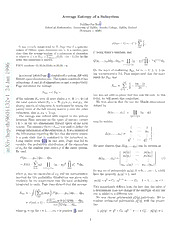Table Of ContentAverage Entropy of a Subsystem
Siddhartha Sen∗
School of Mathematics, University of Dublin, Trinity College, Dublin, Ireland
(February 1, 2008)
mn
1
ψ(mn+1)=−C+ ,
k
It was recently conjectured by D. Page that if a quantum kX=1
system of Hilbert space dimension nm is in a random pure
C being Euler’s constant, and
state then the average entropy of a subsystem of dimension
mn
mwherem≤nisSmn = k=n+1(1/k)−(m−1)/2n.Inthis m
letter this conjecture is prPoved. Q(q ,...,q )dq ...dq = (q −q )2 e−qiqn−mdq .
1 m 1 m i j i i
6 PACS numbers: 05.30.ch,03.65.-w,05.90.+m 1≤iY<j≤m iY=1
9
9 On the basis of evaluating S for m = 2, 3, 4, 5 us-
mn
1 ing mathematica 2.0, Page conjectured that the exact
InarecentletterPage[1]consideredasystemABwith
n result for S was
Hilbertspacedimensionmn. Thesystemconsistedoftwo mn
a
J subsystemsAandB ofdimensionsmandnrespectively. mn 1 (m−1)
4 Page calculated the average Smn = − ,
k 2n
2 k=Xn+1
Smn =<SA >
1 but was not able to prove that this was the case. In this
v of the entropy S over all pure states ρ =|Ψ >< Ψ | of letter, we will prove this conjecture.
A
2 the total system where S = − Tr ρ lnρ and ρ , the We first observe that the van der Monde determinant
A A A A
3
densitymatrixofsubsystemA,isobtainedbytakingthe defined by
1
partial trace of the full density matrix ρ over the other
1
0 subsystem, that is, ρA =TrBρ. ∆(q1,...,qm) ≡ (qi−qj)
6 The average was defined with respect to the unitary i≤iY<j≤m
9 invariant Haar measure on the space of unitary vectors
/ may be written
h | Ψ > in the mn dimensional Hilbert space of the total
-t system. Thequantity(lnm−Smn)wasusedtodefinethe 1 ··· 1
p averageinformationofthesubsystemA.Itisameasureof q ··· q
(cid:12) 1 m (cid:12)
he theinformationregardingthefactthattheentiresystem ∆(q1,...,qm)=(cid:12)(cid:12) ... ... ... (cid:12)(cid:12) .
is a pure state that is contained in the subsystem m. (cid:12) (cid:12)
v: Using earlier work [2,3] in this area, Page was led to (cid:12)(cid:12)q1m−1 ··· qmm−1(cid:12)(cid:12)
i (cid:12) (cid:12)
X consider the probability distribution of the eigenvalues (cid:12) (cid:12)
We next observe that ∆(q ,...,q ) can be written as
of ρ for the random pure states ρ of the entire system. 1 m
r A
a He used p (q ) ··· p (q )
0 1 0 m
p (q ) ··· p (q )
(cid:12) 1 1 1 m (cid:12)
P(p1,...,pmm)dp1...dpm m ∆(q1,...,qm)=(cid:12)(cid:12)(cid:12) ... ... ... (cid:12)(cid:12)(cid:12) (1)
=Nδ(1− p ) (p −p )2 pn−mdp (cid:12)p (q ) ··· p (q )(cid:12)
i i j k k (cid:12) m−1 1 m−1 m (cid:12)
Xi=1 1≤iY<j≤m kY=1 (cid:12)(cid:12) (cid:12)(cid:12)
for anyset ofpolynomialsp (q), k =0,...,m−1,which
k
where pi was an eigenvalue of ρA and the normalisation have the property, p0(q)=1, and
constant for this probability distribution was given only
implicitly by the requirement that the total probability pk(q)=qk+Ck−1qk−1+···+C0, k =1,...,m−1.
integrated to unity. Page then showed that the average
This immediately follows from the fact that the value of
m adeterminantdoes notchangeif the multiple ofany one
S =− p lnp P(p ,...,p )dp ...dp
mn i i 1 m 1 m row is added to a different row.
Z (cid:18) (cid:19)
Xi=1 We now choose polynomials pα(q) judiciously. We in-
=ψ(mn+1)− mi=1qilnqi Qdq1...dqm troduce orthogonal polynomialskpαk(q) with the proper-
R(cid:0)Pmn Qdq(cid:1) ...dq ties:
1 m
R
where q =rp for i=1,...,m, r is positive [1], and 1. pα(q) = qk+C qk−1+···+Cα, pα(q)=1.
i i k k−1 0 0
1
2. ∞dqe−qqαpα (q)pα (q)=hα δ , α=n−m. where we use the fact that ψ(z) = 1 dΓ(z). We now
0 k1 k2 k1 k1k2 Γ(z) dz
R observe that
Polynomialswith these properties are well known. They
are the generalised Laguerre polynomials defined by [4] ψ(mn+1)
eq dk 1 m−1
pα(q)= (−1)k e−qqk+α . − [1+(1+2k+n−m)ψ(1+k+n−m)]
k qα dqk mn
(cid:0) (cid:1) kX=0
We also note, for later use, that [4] mn 1 (m−1)
= + . (7)
k k 2n
pα(q)= k (−1)r Γ(k+α+1) qk−r (2) k=Xn+1
k Xr=0(cid:18)r(cid:19) Γ(k+α−r+1) This follows by examining the coefficient of 1 in
r
∞ m−1
dqe−qqαpα (q)pα (q)=Γ(k +1)Γ(k +α+1)δ (1+2k+n−m)ψ(1+k+n−m)
Z k1 k2 1 1 k1k2
0 kX=0
(3)
and writing
∞ k+n−m
1
dqqa−1e−qpbk(q)=(1−a+b)kΓ(a)(−1)k (4) ψ(1+k+n−m)=−C+ .
Z r
0 Xr=1
recalling that, (1 − a+ b) = (1 −a + b)(1− a +b +
k The third expression in Eq. (6) above is
1)...(1−a+b+k−1). Writing ∆(q ,...,q ) in terms
1 m
othfepsαke(qp)olaysnionmEiaql.s1itainmdmuesidnigattehlye oforltlhoowgsotnhaaltp:ropertyof 2 m−1 k k (−1)k+r Γ(k+n−m+1)
mn (cid:18)r(cid:19) Γ(k+n−m−r+1)
kX=0 Xr=0
S =ψ(mn+1)
mn × ψ(k+n−m+1)−ψ(k+n−m−r+1)
− 1 m−1 ∞ e−q(qlnq)qn−m pmk−n(q) 2dq . ×(cid:2)(r−k−1)kΓ(k+n−m−r+2) (cid:3)
mn Xk=0 Z0 Γ(k+1)Γ(k+(cid:0)1+n−m(cid:1)) Γ(k+1)Γ(k+n−m+1)
m−1
We thus need to evaluate the integral 2 k
= (−1)2k+1
Ik = ∞(qlnq)qn−m pm−n(q) 2e−qdq. mn Xk=0 (cid:18)1(cid:19)
nm Z k (m−1)
0 (cid:0) (cid:1) =−2 . (8)
2n
We first introduce
∞ Since (r−k−1)k = 0, for all r 6=0 and r 6=1, and also
Jk(α)= qα+1 pαk(q) 2e−qdq. ψ(k+n−m+1)−ψ(k+n−m−r+1)=0 whenr =0,
Z
0 (cid:0) (cid:1) we obtain
This integral is easily evaluated. We have
mn
1 (m−1)
Jk(α)=Γ(k+1)Γ(k+α+2)+k2Γ(k)Γ(k+α+1) (5) Smn = k − 2n (9)
k=Xn+1
and we now note that
as conjectured by Page.
dJk(α) ∞ dpα This work is part of project SC/218/94 supported by
Ik = −2 dqqα+1e−qpα k .
nm (cid:20) dα Z k dα (cid:21) Forbairt.
0 α=n−m
Evaluating these two terms using Eqs. (2), (3), (4), and
(5) we find
S =ψ(mn+1)
mn
m−1
1
− 1+(1+2k+n−m)ψ(k+n−m+1) ∗ Electronic address: [email protected]
mn
kX=0(cid:2) (cid:3) [1] D. N.Page, Phys. Rev.Lett. 71, 1291 (1993).
m−1 k [2] E. Lubkin,J. Math. Phys. 19, 1028 (1978).
2 k Γ(k+n−m+1)
+ (−1)k+r [3] S. Lloyd and H. Pagels, Ann. Phys. (N. Y.) 188, 186
mn (cid:18)r(cid:19) Γ(k+n−m−r+1)
kX=0 Xr=0 (1988).
× ψ(k+n−m+1)−ψ(k+n−m−r+1) [4] A. P. Prudnikov, Yu. A. Brychkov, and O. I. Marichev,
IntegralsandSeriesVol.2, GordonandBreachPublishers
(cid:2)(r−k−1) Γ(k+n−m−r+2) (cid:3)
k (1988).
× (6)
Γ(k+1)Γ(k+n−m+1)
2

